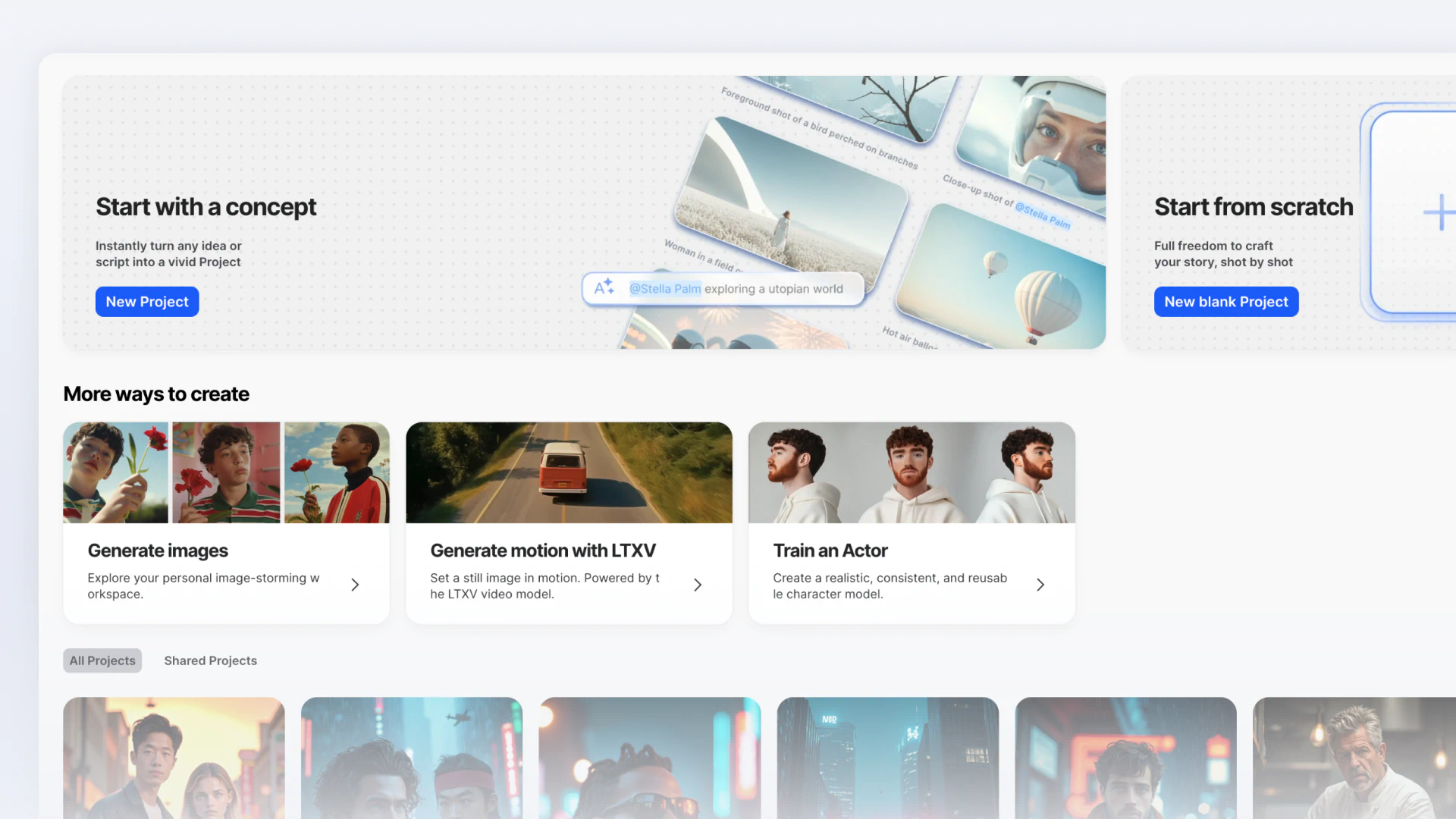The foundation of every video is motion, but thinking about a still image as the first step in creating motion can be a good way to simplify the video motion process!
Think about the concept of “live” photos that show the fraction of a second before and after a shot is taken. They’re essentially micro-videos created from still images. LTX Studio takes this concept even further, allowing you to add professional-grade motion to any photo in just a few steps, seamlessly turning your vision into reality.
This tutorial will guide you through exactly how to use LTX Studio to transform images into videos. Whether you're creating a high-impact marketing campaign or crafting storyboards for film production, LTX Studio’s dynamic tools will help you elevate your project.
How to Use Motion Prompts to Direct Scene Motion
To begin, let’s consider the different ways that you start your motion generation journey in LTX Studio. LTX Studio provides multiple ways to begin your motion generation process, designed to match where you are in your project lifecycle. Depending on your needs, you can use the Image Generator workspace, the Motion Generation workspace, or dive back into one of your Projects.
Use the Image Generator workspace
The Image Generator workspace is designed for text-to-image generation. If you don’t already have images to add motion to, this is a good place to start.
1. Generate images by describing the scene you have in mind.
2. Save the generated images to your computer or directly upload them to your project.

Jump into the Motion Generation workspace
Already have images you’d like to animate? Or maybe you’ve already completed steps one and two above! In this case, the Motion Generation workspace is where you want to begin – it’s specifically designed to add movement to static frames in just a few clicks!
1. Upload your image and drag it into the “start frame” area.
2. Use the Motion Prompt box to describe the kind of movement you want, like “waves crashing” or “leaves blowing in the wind.”
3. Preview the results and refine the motion with more prompts or adjustments.
Start with a Project
For creators already in the storyboarding phase of a project, LTX Studio allows you to seamlessly integrate motion at the project level. This approach is perfect for longer video compositions where you’re connecting multiple scenes and enhancing narrative flow.
1. Access the Motion Editor tab within your Project view.
2. Use the motion options on the left hand side of your workspace to start adding motion to scenes!
Now that you know how to get started, let's dive into advanced tools to refine your motion.
Frame Animation as the Foundation for Combining Photo and Video
Frame animation is LTX Studio’s core tool for transforming still photos into dynamic shots, with AI-generated motion suggestions that streamline the process even further.
Here’s how to use frame animation tools effectively:
1. Upload your image into the workspace and click "Generate Video."
2. Preview the four AI-generated motion options and select the one that aligns with your vision.
3. Want to customize further? Add a Motion Prompt like “talking” or “whispering” to guide the AI.
This approach creates shots that can serve as the foundation for more complex storyboarding techniques.
Adjusting Camera Control to Refine Start and End Points or Select from Presets
Camera control is a game-changer when it comes to refining motion. By using this tool, you can adjust how the camera moves within the frame.
Steps to Use Camera Control:
1. Set your own start and end points within the frame or use preset motion paths.
2. Explore presets on the left-hand panel to experiment with different camera movements, such as “zoom in” or “tilt up.”
3. Use the "Play Preview" option to test the motion before rendering your video – this saves time while you’re still making adjustments.
4. Click "Apply" to generate the animation!
Leveraging Keyframe Controls to Create Transitions Between Frames
For more precise control to create video transitions, keyframes allow you to implement a seamless flow between frames. Here, you can create your ideal in-frame motion by setting your start and end points, refining them with LTX Studio’s editing tools, and adding a prompt to tie everything together.
How to Use Keyframe Control:
1. Click set frames to double-click into Keyframe Control.
2. Duplicate your start frame by clicking the small button on the upper left hand side of your image – hint: it’s a little box with a plus sign!
3. Adjust individual frame elements, using “generative fill” and “remove objects” as needed.
4. Add a Motion Prompt to clarify what you want to change, such as “clouds forming” or “city lights fading.”
Keyframe Motion ensures smooth flow between frames and lets you create intricate, professional-grade transitions, but it’s just one option for adding motion!
Uploading Shots to Generate Seamless Motion Between Scenes
One of LTX Studio’s standout features is its ability to create motion automatically between consecutive shots. This simplifies the process of transitioning between scenes, and allows you to choose the images you like the most while AI does the heavy lifting!
Steps for Seamless Scene Motion:
1. Upload your image into the "end frame" box – hint: to the right of the duplicate button!
2. LTX Studio fills in the missing elements, creating a motion path between the two frames.
3. Apply the changes!
4. Review the four AI-created motion options and select your favorite to render!
This feature is perfect for filmmakers and marketing teams who need to produce polished videos efficiently and quickly, working directly from images for reference.
Extend Shot Duration and Upscale to HD for a Cinematic Finish
No video is complete without polished, high-quality visuals! With LTX Studio, you can enhance your shots further by extending durations and upscaling to HD. You can upscale your favorite shots to HD by applying the platform’s upscaling tools, and adjusting duration is as easy as a click of a button.
Don’t forget to click “Generate video” to implement the changes!
Unlock Endless Creative Possibilities Using LTX Studio
Motion control tools allow you to create dynamic visuals with subtle adjustments or major changes to match your wildest dreams. Whether you’re crafting an engaging ad campaign or piecing together a cinematic storyboard, LTX Studio is the tool you need to bring your vision to life. While it can take some time to get the hang of the different ways to add motion to your images, each of these methods combines photo into video in a way that will simplify your workflow.
Want to see these tools in action? Check out LTX Studio’s YouTube tutorial for a step-by-step guide – or better yet, transform photos to video by exploring the platform yourself!
{{blog-banner-video08}}
Turn Photo Into Videos FAQs
How do you turn a photo into a video with motion?
Use LTX Studio's Genspace by uploading your image to the start frame area, describing the movement you want in the Motion Prompt box (like "waves crashing" or "leaves blowing"), and previewing AI-generated motion options. The platform provides frame animation, camera controls, and keyframe tools for professional-grade motion.
What is the best tool to animate still photos into videos?
LTX Studio is the best tool for animating photos into videos, offering multiple methods including frame animation with AI-generated motion suggestions, camera control with preset movements like zoom and tilt, keyframe controls for precise transitions, and automatic motion generation between consecutive shots for seamless scene transitions.
Can you create professional video transitions from images?
Yes, using LTX Studio's keyframe controls you can create professional transitions by setting start and end frames, duplicating frames, adjusting elements with generative fill and object removal tools, and adding motion prompts to clarify changes. The platform also extends shot duration and upscales to HD for cinematic quality.















.webp)



.png)







